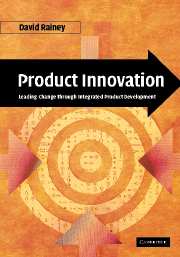Book contents
- Frontmatter
- Contents
- Preface
- Acknowledgements
- Part I Product innovation and strategic logic
- Part II Establishing the foundation: the conceptual level
- Part III Methods and techniques for analysis and decision making
- Part IV The operational level and concluding remarks
- Glossary
- References
- Select bibliography
- Index
Part II - Establishing the foundation: the conceptual level
Published online by Cambridge University Press: 10 August 2009
- Frontmatter
- Contents
- Preface
- Acknowledgements
- Part I Product innovation and strategic logic
- Part II Establishing the foundation: the conceptual level
- Part III Methods and techniques for analysis and decision making
- Part IV The operational level and concluding remarks
- Glossary
- References
- Select bibliography
- Index
Summary
At the dawn of the twenty-first century, leading businesses are focusing on innovation as the means for achieving their strategic objectives and obtaining competitive advantages. Strategic management's priorities are shifting from focusing on the product delivery system and selling products to leading change through creativity and discovering new opportunities in the business environment. Conventional new-product development (NPD) approaches are evolving into powerful, comprehensive management processes and techniques that integrate opportunity, innovation, and the development process into highly capable and responsive constructs. For example, General Electric's (GE's) Chief Executive Officer (CEO) Jeffrey Immelt wants GE to focus more on innovation, and to become the leader in introducing new products and services.
The conceptual level involves the exploration of new-product ideas, the maturation of new-product concepts, the selection of appropriate opportunities for further development, and the determination of the overall game plan for the NPD program. The conceptual level as defined in Chapter 2 includes the activities and decisions necessary for laying the foundation for the successful design and development, and commercialization of a new product. The road has many pitfalls, problems, and challenges as organizations have to respond to the ever-changing landscape of demanding customers and concerned stakeholders. The NPD process has to be systematic, yet flexible enough to accommodate shifting requirements over time.
The conceptual level aims at managing Idea Generation, Concept Development and Selection, and Program Definition phases in an integrated fashion that is both comprehensive and expeditious.
- Type
- Chapter
- Information
- Product InnovationLeading Change through Integrated Product Development, pp. 147 - 148Publisher: Cambridge University PressPrint publication year: 2005



